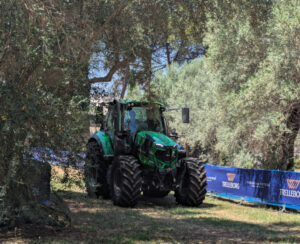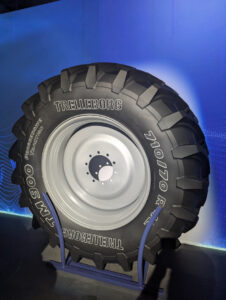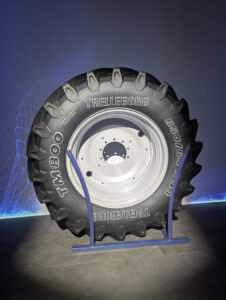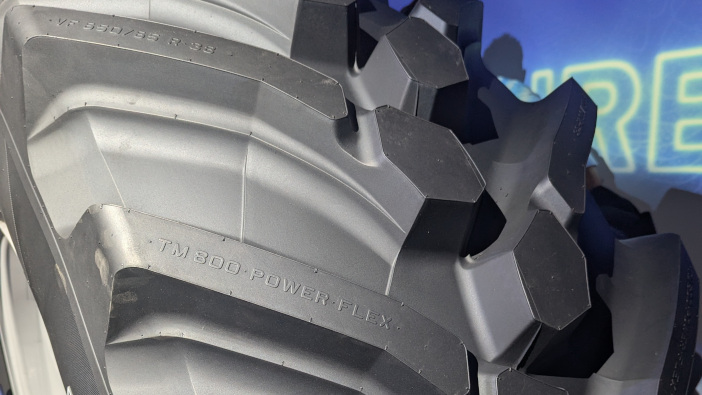At the company’s factory near Tivoli, Italy, Trelleborg walked us through the latest developments in the ProgressiveTraction range
The Tivoli factory is located in a beautiful part of the world, about an hour from Rome, looking more like a stately home than a tyre factory. Trelleborg, now known as Yokohama-TWS following its acquisition in 2023, states that it was one of the only agricultural tyre factories in Europe to take product development from compound development, through moulding and product testing.
This direct channel from product development through to research and development reportedly allows the company to react quickly to customer demands, using a mix of natural and synthetic rubbers, oil and carbon black to create different strengths and sidewall rigidities to create new products.
This wasn’t just an opportunity to explore the factory, however. Three new updates were announced for the Trelleborg range, filling out the mid and high horsepower offerings and all built around the ProgressiveTraction tread design.
ProgressiveTraction
Available for over a decade now, the ProgressiveTraction design utilises a double lug, with the second lug moulded to the main tread. When working in the field, this is said to provide a second anchor point, which improves the traction.
The increased rubber within the footprint also adds benefits, as it spreads the weight of the tractor more evenly over the soil surface, especially when linked to a central tyre inflation system (CTIS) and places more rubber on the road during transport, which the company states will reduce vibrations.
Utilising both very high flexion (VF) and pressure field operation (PFO) technology, the new range of TM800 PowerFlex shoes will have six sizes by the end of the year, starting with the 480/65 R28 and topping out with the 710/70 R38.
 Like cyclic field operation (CFO), PFO enables the tyres to handle greater loads during field operations. While CFO relates to machines such as slurry tankers or combine harvesters, where the load changes dramatically between empty and full, PFO enables a higher constant load in the field when within the general working speeds – between 5kph and 15kph.
Like cyclic field operation (CFO), PFO enables the tyres to handle greater loads during field operations. While CFO relates to machines such as slurry tankers or combine harvesters, where the load changes dramatically between empty and full, PFO enables a higher constant load in the field when within the general working speeds – between 5kph and 15kph.
According to Alessio Bucci, global product marketing director, this additional load can be as much as 17% when compared to a standard tyre, enabling larger implements to be handled without overloading the tyre. As it also uses VF technology, it comes with the same benefits that other VF tyres offer – a 40% increased load at standard pressures, or the ability to reduce the pressure by up to 40% while carrying the same load as a standard tyre.
“In testing against premium competitors, we’ve seen a 20% increase in traction during field operations with the TM800 PowerFlex,” adds Alessio. “The range also offers a 5% wider footprint and a 5% increase in self-cleaning capabilities.”
The range also includes a bead construction that reportedly makes it easier to mount on the rim, with additional reinforcement to limit slippage. While it retains the ProgressiveTraction double lug design, changes have been made to the central rib. Inspired by automotive designs, the lug splits at the centre to create a central strip of rubber.
Alessio notes that this central rib can reduce rolling resistance by up to 6%, while the overall roadability and handling is improved by around 5% when compared to premium competitors. “The combination of VF and PFO technologies, with that new tread design, can also increase the tyre life by up to 20%.”
 New shoe sizes
New shoe sizes
During the event, there was also the official launch of the TM900 range, which slots between the existing TM800 and TM1000 series, designed for high-horsepower machines. A total of six sizes were announced, running from the 600/70 R28 up to the 710/70 R42, with more expected throughout 2026.
While not including the PFO technology, Alessio noted that many of the benefits crossover between the PowerFlex and the standard ProgressiveTraction VF range. This includes the potential 20% increase in tyre life and the 17% increase in traction during field operations.
The TM900 does not have the central rib tread design, but Trelleborg does point out that the long lugs widen in the middle of the tyre to provide a similar effect for more comfortable roading.
Within the standard TM800 range, there was also an announcement of new sizes, bringing the range up to six boots with more to be released for 2026. The series now extends from 480/65 R28 up to 710/70 R38, with the company focusing on mid-power tractors.
 Recognising the multi-purpose use of machines this size, the carcass has been reinforced for better handling on the road and on hard surfaces, reportedly offering an 18% increase in tyre life. The dual anchor on the ProgressiveTraction tread also offers a 17% increase in traction on soft soils, and 10% on hard or compacted ground.
Recognising the multi-purpose use of machines this size, the carcass has been reinforced for better handling on the road and on hard surfaces, reportedly offering an 18% increase in tyre life. The dual anchor on the ProgressiveTraction tread also offers a 17% increase in traction on soft soils, and 10% on hard or compacted ground.
The standard TM800 range does not include VF technology, but as the sizes are the same across both the standard and the PowerFlex series, users will be able to specify their TM800s to suit their systems.
A reminder of the range
Alessio also ran through some of the developments launched in recent years. This included the ART1000 rubber track – a new market for the company. Only a single size is available now, with a 635mm track width and a 6,634mm length, built around a specially designed compound which is said to be wear-resistant.
There was also a reminder of the TM1 EcoPower, developed alongside the Fendt e100 Vario electric tractor. Using 65% renewable materials, including rice bran power, cashew nut oil, recycled carbon black and bio-nylon, the tyre is said to have a lower carbon footprint, as well as a unique, hard-wearing tread design for hard surfaces that can reduce rolling resistance by up to 47%. This is key for electric machinery, as a lower rolling resistance can reduce the drain on the battery.
Finally, the company showcased its PneuTrac specialist tyre, initially developed alongside New Holland. This has the ProgressiveTraction tread pattern but uses CupWheel technology within the sidewall. This allows the tyre the sidewall to invert as the pressure is lowered, allowing to carry a large load and widen the footprint to something comparable to a track.
Six sizes are available, all for specialist vineyard or orchard tractors. Speaking to Alessio, he said that one of the benefits of the design was the improved stability on steep inclines and side hills, making it especially suitable for European vineyards. “However, there are benefits to the technology on larger tractors, and this is something we’re exploring at the moment.”


